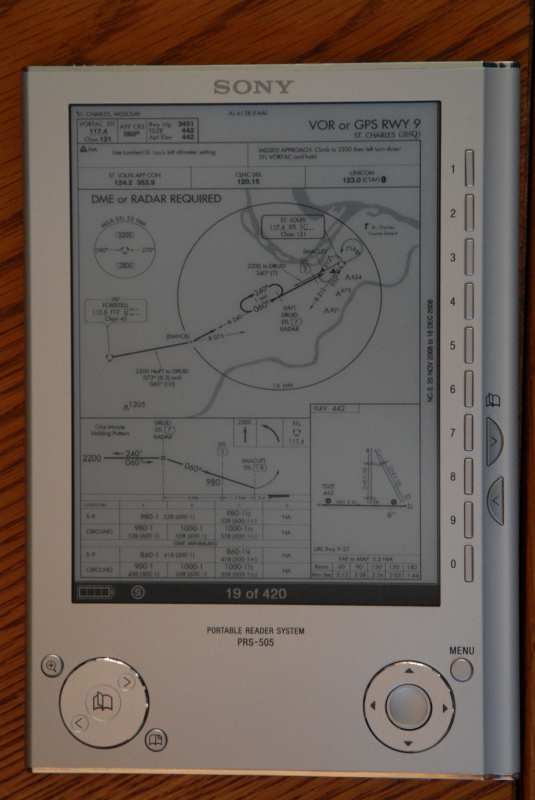I purchased my Sony PRS-505 ebook reader primarily to run Reader Plates. This is a set of electronic IFR approach plates or, to be technically correct about the name, the FAA (NACO) Terminal Approach Procedures. When I fly IFR (in the clouds), I use these half-page charts when taking off from or landing at an airport. For example, here is the St. Charles Municpal Airport GPS 9 Approach. Several things bother me about these charts. We kill too many trees producing them; the FAA sends me a 3″ stack of paper every 28 days, and I only subscribe to three of the 17 books in the United States set. The things are expensive; including shipping I am paying about $23 for every set of three books. The things are heavy and bulky; by far the heaviest thing in my flight bag on a cross country flight is the approach plates. And last but certainly not least, they are inconvenient; it is a royal PITA to assure that I have the books for distant states before leaving home, especially since they have to be mail ordered.
A small company just released an electronic version of the terminal approach procedures which actually makes sense to me. Reader Plates offers the entire set of approach plates, everything in the US, for a very reasonable $9.99 per month on a device which fits both my cockpit and my wallet. The Sony PRS-505 is about the size of half a sheet of paper, so it fits nicely on my kneeboard. At $299, the PRS-505 is one third the price of the eFlyBook and the $9.99 per month subscription works out to less than half the cost of the chart subscription for the eFlyBook. And I love being able to carry all the charts for the entire US in a ½” thick package.
Last week, I tried it out, flying both day and night approaches using the PRS-505 in lieu of paper. It worked great.
My first stop was at the local office supply store where I bought one of those rubber pads that you are supposed to stick on the dashboard of your car so that you can plop your cell phone on the dash and keep it from sliding onto the floor. I stuck that onto the back of the Sony Reader so that it would not slide off my kneeboard. With the pad in place, I took off into the wild blue yonder (with a safety pilot in the right seat, of course).
The screen on the Sony Reader is 6″ diagonally. Fold a sheet of paper in quarters and you will be in the ballpark. Reader Plates presents an entire approach plate on this screen and it is surprisingly readable, even with my eyes which need reading glasses. (Click on the image to see it larger.)

Since this is pretty small, pressing the center of the navigation wheel (lower, right corner of the PRS-505) magnifies the image, zooming in on the top half of the chart. In this mode, the image is exactly the same size as the printed approach procedures.

Pressing the center of the navigation wheel a second time switches to a magnified view of the bottom half of the chart. Pressing a third time cycles back to the full page view. Reader Plates has a larger set of screen snapshots on their web site.
This actually works out quite well for me. When I fly an approach, I prep by looking at the whole page and getting an impression of the overall route which I will be flying. After that, I really only look at the bottom half of the chart, constantly reminding myself of the MDA or DH. I leave the lateral navigation to the GPS with its moving map display and the CDI needle.
The Sony Reader takes its time doing things when you press buttons, so it requires several seconds (and several button pushes) to navigate from one chart to another. This is generally not a problem except after landing, if you need to quickly switch from the approach plate to the airport diagram. In this one case, you may find it handy to have the airport diagram on paper.
Having initiated Reader Plates with my day practice approach and a night IFR flight from Kalamazoo back to St. Charles, I am thrilled with the combination of the Sony Reader and Reader Plates. I have already cancelled my subscription to the paper terminal approach procedures and plan to use the PRS-505 on a 2,200 mile cross country trip in a couple of weeks.
There are several concerns about electronic charts, especially for the landing phase of flight which is particularly critical. I have given them some serious thought since I am kind of fond of being alive:
- What if the battery dies? The Sony Reader uses eInk technology so it only uses power when you change pages; when simply displaying an image, it consumes absolutely no electricity. With an advertised battery life of 7,500 “page turns,” I don’t worry about running out of batteries during a flight.
- What if the PRS-505 dies? It is unlikely since the Sony Ready is pretty durable and, other than the switches, has no moving parts. But if the PRS-505 did expire mid-flight, it would not be the end of the world if I had to fly an approach without the chart. My plane is equipped with a KLN94 IFR GPS and that has a database of all approach procedures. Beyond that, I would need someone on the ground to tell me the MDA or DH for the approach, and that would be a hassle, but I would get safely to the runway.
- But the Sony Reader does not have a light. Neither do the paper charts that it is replacing.
If you are an IFR pilot, give Reader Plates a serious look. I think you will like what you see.
